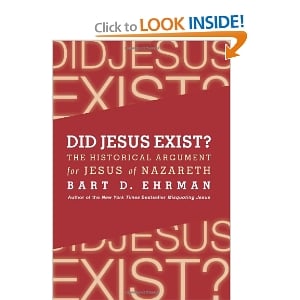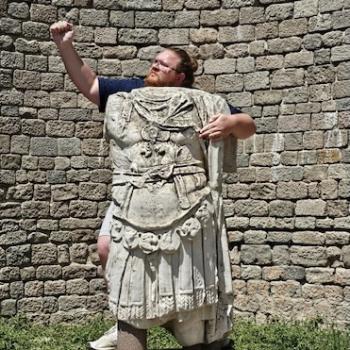Q. In both the past and the present, people have often drawn parallels between Jesus and Apollonius of Tyana, a real person who lived some 50 years after Jesus’ day, and had a biography written about him by Philostratus which considerably post-dates our canonical Gospels. As you point out, even when we compare these two historical figures, or, for example compare Jesus to some of the lives of the Caesars, we have no stories in pagan literature about a virgin who becomes pregnant without sex or a story about a crucified messiah or divine figure. Why do you think it is that parallelomania seems to be such a popular modus operandi for mythicists who want to explain away the existence of Jesus, especially when various of the supposed parallels are in fact made up? And one more thing—- why shouldn’t we think that the pre-existing Gospel stories may have influenced the way the story of Apollonius of Tyana was later told, rather than vice versa?
A. There are several points that need to be made, I think, about all the parallels that exist between the stories of Jesus and other supposed “divine men” of ancient Greece and Rome. The first is that there were indeed a number of similarities between the ways Christians talked about Jesus and the ways pagans (and in some instances, Jews) talked about other “sons of God.” There is no point denying this (it comes as a huge surprise to my students). We have stories of other “divine men” from antiquity who were thought to have been supernaturally born; to have been preternaturally wise, religiously, while still youths; to have engaged in itinerate preaching ministries; to have done miracles such as miraculously feeding the hungry, casting out demons, healing the sick, raising the dead; and at the end of their lives to have ascended to heaven. These other stories do exist (and not just about Apollonius of Tyana.)
But – the second point – the fact that Jesus was talked about in ways similar to how others were talked about does not mean that he (or they) did not exist. Some of these stories are told about figures who are absolutely and incontrovertibly historical (Alexander the Great; the Emperor Vespasian; Apollonius; and so on). If you wanted to tell stories about a figure you considered to be more than human, to be in some sense divine, these are the kinds of stories you told. That means that the stories about Jesus may well have been shaped by the expectations of the Jewish and pagan audiences to whom they were told, so that one needs to take that into account when deciding what actually happened in Jesus’ life. But as I indicated in my previous answer, this is unrelated to the question of whether Jesus actually existed.
And finally – my third point – it should be stressed that all of these figures about whom such stories were told were also different in key ways from one another. They were not all the same. The stories varied from one person to the next. The stories about Jesus are different in many ways from the others (just as each of them is different from the others). This is important to bear in mind because mythicists often claim that everything said about Jesus can be paralleled in the myths and legends told about other divine figures on earth. And that simply is not true. A number of the key stories about Jesus are in fact unique to him, including some of the most important.
Just to take two examples. As I spell out at greater lengths on one of my blog posts, even though there are numerous instances of divine men who are supernaturally born, there is no instance of a divine man being born to a “virgin,” as happens in the case of Jesus, for example in the Gospel of Matthew. The entire point of most of the pagan supernatural birth stories is that a (mortal) woman is made pregnant by a God, precisely by having sex with her (often in human form, though sometimes Zeus preferred being in the form of a swan, or a snake, or…. some other animal, for some odd reason). I don’t know of any instances in which a woman gives birth as a virgin. So too: the resurrection. The Gospel understanding of the resurrection is that Jesus came back into his body (a one-time corpse) which was then transformed and raised and exalted (explicitly in Luke-Acts) to heaven. This reanimation of the body type of resurrection is not attested, so far as I know, for any other divine man in antiquity.
This is an important point because mythicists want to claim that all the stories about Jesus were simply taken over from the pagan environment. And this is simply not true.
Q. It appears that mythicists have not read Jonathan Z. Smith, and do not realize that there is no unambiguous evidence for the historical argument that ancients believed in dying and rising gods before the time of Jesus, and that therefore the story of Jesus is just a historicized version of that myth. Why do you think this theory of dying and rising gods became so popular in the 20th century, and what caused its scholarly demise? Was there new evidence that Smith and others unearthed, or just closer reasoning about the existing evidence?
A. Yes, for a long time it was widely thought that dying and rising gods were a constant staple of ancient pagan religions, so that when Christians claimed that Jesus had been raised from the dead, they were simply borrowing a common “motif” from pagan religions. This view was first popularized by Sir James George Frazer at the beginning of the twentieth century in his enormously influential (and very large) book, The Golden Bough. (As I explain in Did Jesus Exist, Frazer did in his day what Joseph Campbell did in ours – popularized the view that at heart, all religions are basically the same).
This view was exploded by Jonathan Z. Smith in the late 1980s, chiefly in an article on the “dying-rising gods” in the scholarly and authoritative Encyclopedia of Religion. Smith showed that the notion that there was a widespread category of gods who died and rose again was, in fact, a modern myth, not based on a careful reading of ancient sources. In his own words: The category of dying and rising gods, once a major topic of scholarly investigation , must be understood to have been largely a misnomer based on imaginative reconstructions and exceedingly late or highly ambiguous texts….
All the deities that have been identified as belonging to the class of dying and rising deities can be subsumed under the two larger classes of disappearing deities or dying deities. In the first case the deities return but have not died; in the second case the gods die but do not return. There is no unambiguous instance in the history of religions of a dying and rising deity. (Jonathan Z. Smith, “Dying and Rising Gods,” Encyclopedia of Religion, 2nd ed. Lindsay Jones, (Detroit: Macmillan, 2005 [original: 1987]), 4:2535)
Smith’s findings were based not on new discoveries, but on a more careful reading of ancient sources. Unfortunately, even though these findings have made a major impact on the research of New Testament scholars and other scholars of Christian antiquity, they appear to be unknown to the mythicists, many of whom continue to make the now dated claim that the resurrection of Jesus was simply invented along the lines of the common pagan myth.
Q. In what way is the Jewish notion of a resurrection a different idea than either the fertility crop cycle idea, or what is sometimes said about pagan deities that either disappear or die?
A. One of the reasons for thinking that the belief in Jesus’ death and resurrection is not exactly like what you can find in pagan myths about their gods is that it is solidly rooted in Jewish apocalyptic beliefs of the first century. This should come as no surprise, since Jesus and his followers were not pagans with pagan views of the divine realm, but first-century apocalyptically minded Jews. In some pagan circles, there was a belief in fertility gods, who would spend some time in the underworld and some time in this world, alternating year after year. These gods were closely connected to the crops: they (both the crops and the gods connected with them) die in the winter and come back to life in the Spring. And they do that year after year. That obviously is not like the early Christian belief in Jesus, who does not go into the underworld then return to this world year after year. Instead, Jesus was believed to have gone to the underworld for three days and then to have been raised from the dead and exalted to heaven where he is to stay until he returns. This is not rooted in pagan mythology, but in apocalyptic theology.
To explain how “resurrection” is a Jewish apocalyptic idea, it is necessary to give a bit of background on Jewish apocalyptic thought. According to apocalypticists of ancient Judaism, this world controlled by forces of evil who were making life miserable for people, especially those who sided with God. That’s why there is so much pain and misery all around us. God is not doing it. The powers of evil are doing it (for example the Devil, the demons, the powers of sin and death). But God, these apocalypticists believed, was soon to intervene in history, overthrow the forces of evil, and set up a good kingdom here on earth. When he did that, he would destroy all people who sided with evil, and reward all those who sided with him. And this applied not only to people who were living at the time, but also those who had died. All people would be raised from the dead to face judgment, either eternal punishment or eternal reward. Moreover, this was to happen very soon – within their own generation!
Jesus himself preached an apocalyptic message of the coming judgment and the entrance of the Kingdom of God, to appear very soon. This would include a resurrection. Som time after Jesus was arrested, tried, and crucified, some of his followers (all of them? It’s hard to say) came to believe that he had been restored to live and exalted to heaven. They interpreted this as an act of God, and understood it to be a “resurrection.” The implications for them were clear and certain, and they are not the implications that Christians typically draw today. For these ancient Jewish apocalypticists, if Jesus was raised from the dead, that means that the resurrection – to come at the end of time – had already started. In other words, the kingdom was virtually here!
That’s why Paul calls Jesus the “first fruits of the resurrection.” He was the first to be raised, and everyone else will soon follow suit, very soon, very very soon indeed. Paul expected to be alive when it happened.
This apocalyptic notion of resurrection is rooted in a belief that even though this world is filled with pain and suffering, God is ultimately sovereign, and he will have the last word. By raising Jesus, he has started the sequence of events that will transpire at the end. This is not a belief rooted in pagan ideas of a dying-rising god (if there ever were such ideas). It is a belief rooted in a Jewish apocalyptic worldview.
Q. The technique used by Frazier, and by later mythcists to reconstruct a pagan model of a dying and rising god which then is assumed to be the prototype on which Jesus is supposedly modeled has been called ‘the synthetic fallacy’. Whats wrong with the notion of cherry picking ideas from various ancient religious stories and then constructing a paradigm out of it which is supposed to be the basis for the Jesus story? To what degree do you think Frazier’s Golden Bough suffers from reading the pagan evidence on the basis of Christian views and assumptions, and so reading that evidence wrongly?
A. I’ve covered some of this in my discussion of Frazer earlier.
Q. The views of G.A. Wells seem in various ways to be different from other mythicists. He argues that Paul thought Jesus existed long before the first century, and that the Jewish personification of Wisdom was used to create the mythical Jesus. What’s wrong with this sort of reasoning about the historical Jesus? Why does it seem that persons like Wells and Doherty are prepared to grasp at straws or extreme arguments to prove their point, using an ‘any stick to beat a dog’ kind of approach to the Jesus question?
A. G. A. Wells is probably the best known mythicist of modern times, although, interestingly, he has shifted his perspective on the existence of Jesus. In his early writings Wells maintained the standard mythicist view that there never was a Jesus who lived. But as he did more research (he is not a New Testament scholar or a scholar of early Christian history; his field is modern German intellectual history) he came to realize that yes, there actually was a Jesus. Rather than completely backtracking on his earlier published views, however, Wells simply modified them so that he no longer said that Jesus did not exist, but that the Jesus who existed is virtually unrelated to the person we think of as Jesus of Nazareth. Specifically, for Wells (now), Jesus was not the Galilean preacher/healer of the first century. That figure is the creation of the Gospel of Mark. Jesus was a completely unknown and obscure Jewish figure who lived over a hundred years earlier. Christ on the other hand was an invention of a Jewish sect of the first century, based on their understanding of Jewish myths about “Wisdom.”
These Wisdom traditions are based on passages such as Proverbs 8, where “Wisdom” is said to have been with God in the beginning and to have created the universe. The early Christians called Jesus God’s “Wisdom” (e.g., 1 Corinthians 1:23-24), and so had begun to imagine him as that one referred to in Proverbs. This was not in reference to the man Jesus who lived in almost complete obscurity a hundred years earlier, however. This was a myth that they invented about the divine Christ, God’s Wisdom.
This view is a bit complicated, but I spell it out in greater length in Did Jesus Exist. Among other things I show that the references in Paul to Jesus do not make sense if they are referring to a person who lived in obscurity a hundred years earlier, and that it is completely implausible that the entire “Christ myth” was invented on the basis of Jewish ideas about “Wisdom,” since Jesus was not primarily identified as Wisdom in the earliest traditions about him, but instead, precisely, as the Messiah – and a crucified messiah at that (Wisdom is never called the messiah in Jewish sources). This shows that Christians knew that Jesus had lived. Recently. And they knew that he had been crucified. But they called him the messiah anyway.













